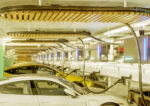
Although they may be just beguiling mirages that will fade upon approach, there are some submarkets where asking rents have jumped in the past months, a trend that runs counter to the dour predictions from Manhattan leasing brokers that taking rents won’t rise for more than a year.
In the Meatpacking District, for example, Charles Blaichman’s CB Developers High Line building that remains under construction at 450 West 14th Street has asking rents above $100 per square foot. The space was added to the availability list in January, driving up average rates in the district, the most recent figures from commercial firm Jones Lang LaSalle show.
And in the Union Square submarket, the average asking rent rose by 14 percent with the addition of space at 300 Park Avenue South, commercial firm CB Richard Ellis’ latest report said.
Overall, CBRE found eight of Manhattan’s 18 submarkets showed increases in asking rents, compared with just one market that showed an increase in January one year ago.
While the spikes in asking rents pushed up the prices in some areas, they were not the norm, and the overall average asking rent for Manhattan declined last month by $0.15 per foot, to $48.86 per square foot. It is now down 32 percent from the high in July 2008 of $71.92 per foot, CBRE figures show.
Derek Trulson, a managing director at Jones Lang LaSalle, summed up the view of many brokers, with a hint of exasperation.
“The latest buzz is we are going to be bouncing around the bottom for the near future, and everyone can say the near future is 12 to 18 months without looking too ridiculous,” Trulson said, then added, “I think we have been saying ’12 to 18 months’ for 24 months now.”
Although brokers were skeptical the new Meatpacking District building would achieve a rent over $100 per foot, there were tenants reviewing leases for the seventh, 13th and 14th floors of the 15-story building, data from commercial data firm CoStar Group shows.
Newmark Knight Frank, which is representing the building owner, declined to comment.
Nicola Heryet, senior managing director of Cassidy Turley (which was formerly known as Colliers ABR), said she expected a tenant would be in the fashion industry.
However, she did not have direct knowledge of the leases, she said.
“It is a unique little building with high ceilings. Are they going to pay $100? I doubt it. But it will command a higher rent. That is a one-off building,” she said, comparing it to the upper floors of the General Motors building or 9 West 57th Street.
She said in general, the current tenants’ market precluded landlords from raising rents. She cited research her firm undertook in August, and then again in January, that showed no asking rent increases among available 50,000- and 60,000-square-foot spaces in about two dozen buildings in the heart of Midtown.
When her research department ran the numbers again in mid-January, some spaces had been taken and others had leases under review, but “I did not see any increase in rent,” Heryet said.
“I don’t think you will see increases in rent,” she added, addressing the near-term. “The market has not turned yet.”
Heryet cautioned that despite what is considered a tenant-friendly market, tenants are anxious about the economy. She said in recent months she saw for the first time in this recession tenants asking for the right to cancel the lease, which is a protection against the feared “double dip.”
“I think that is a hedge tenants are asking for in case there is another downturn,” she said, although she noted that landlords were not giving the condition up easily.
Midtown
The average asking rent and availability rate remained largely unchanged in January, supporting some brokers’ views that the market has stabilized, CBRE data showed.
In another sign brokers viewed as positive for Manhattan, Steven Pozycki’s SJP Properties and law firm Proskauer Rose are at the lease-review stage for 388,000 square feet in the 1.1 million-square-foot 11 Times Square building, according to an industry source.
“With Proskauer, that would be [an example] of a service firm taking advantage of the market for a long-term move,” said Ted Rotante, a senior managing director at FirstService Williams who was not involved in the deal. “If Proskauer took it they would have to get some efficiency” to make the move from 1585 Broadway worthwhile, he said.
The average asking rent in Midtown was $56.07 per square foot, up by $0.05 from the prior month, and the availability rate remained flat at 14.8 percent, CBRE data showed.
The leasing volume fell to 1.37 million square feet from December’s breakneck pace of 1.6 million, but remained above the five-year monthly average of 1.2 million square feet.
Midtown South
Average asking rents improved the most in Midtown South compared to the other markets, but in a sign of the uneven economy, it was the only area of the three where the availability rate rose.
Landlords were asking an average of $41.66 per square foot in January, or $1.13 more per square foot compared with December, while the availability rate rose modestly by .2 points to 15.4 percent.
The amount of space leased in Midtown South declined slightly, to 310,000 square feet, but the amount of negative net absorption was 330,000 square feet, the largest figure of the three markets, CBRE figures showed. Net absorption measures the change in the amount of space that is occupied during a given period.
Downtown
Property owners Downtown lowered average asking rents by $0.47 per square foot in January to $37.65 per foot, CBRE figures showed.
While brokers have long expected a downturn in the market because of large increases to inventory, the district remains tighter than the others in terms of availability rate, which remained unchanged at 11.5 percent in January from December, according to CBRE.
However, financial firms are returning space to the market. In January, JPMorgan Chase put 248,000 square feet of sublease space on the market at 4 New York Plaza, a 1.1 million-square-foot building it sold in January for $107 million to a partnership between Josh Zamir’s Capstone Equities and Virginia-based real estate company Harbor Group International.



